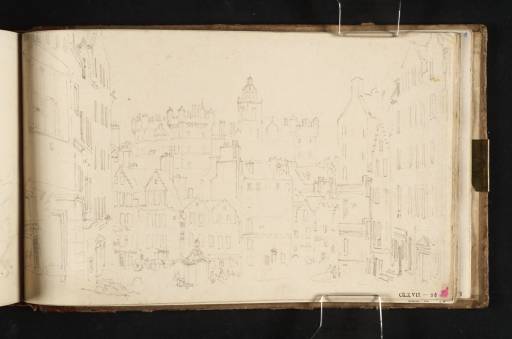Joseph Mallord William Turner Heriot's Hospital 1818
Image 1 of 2
Joseph Mallord William Turner,
Heriot's Hospital
1818
Joseph Mallord William Turner 1775–1851
Folio 75 Recto:
Heriot’s Hospital 1818
D13744
Turner Bequest CLXVII 86
Turner Bequest CLXVII 86
Pencil on white wove paper, 112 x 186 mm
Inscribed in pencil by Turner, lower left ‘Bull Inn | Red | Dunno Salar’, lower right of centre ‘w[...]’, and on various buildings ‘w’
Inscribed in red ink ‘86’ bottom right
Blindstamped with the Turner Bequest stamp bottom
Stamped in black ‘CLXVII 86’ bottom right
Inscribed in pencil by Turner, lower left ‘Bull Inn | Red | Dunno Salar’, lower right of centre ‘w[...]’, and on various buildings ‘w’
Inscribed in red ink ‘86’ bottom right
Blindstamped with the Turner Bequest stamp bottom
Stamped in black ‘CLXVII 86’ bottom right
Accepted by the nation as part of the Turner Bequest 1856
References
1909
A.J. Finberg, A Complete Inventory of the Drawings of the Turner Bequest, London 1909, vol.I, p.487, CLXVII 86, as ‘Heriot’s Hospital.’.
1997
Charles Nugent and Melva Croal, Turner Watercolors from Manchester, exhibition catalogue, Memphis Brooks Museum of Art, Memphis 1997, p.62.
1999
Katrina Thomson, Turner and Sir Walter Scott: The Provincial Antiquities and Picturesque Scenery of Scotland, exhibition catalogue, National Gallery of Scotland, Edinburgh 1999, p.90 reproduced fig.23.
This sketch formed the basis of Turner’s watercolour design of Heriot’s Hospital, Edinburgh, circa 1819 (National Gallery of Scotland),1 for the seventh number of the Provincial Antiquities. The view is taken from the West Bow – the crooked street that connects the Lawnmarket to the Grassmarket, and was the route to the gallows for condemned prisoners. The Grassmarket, home of Edinburgh’s poorer inhabitants and tinsmiths at this time, lies perpendicular to the West Bow and the sketch gives a sense of its colour and variety with the buildings of various styles and sizes lining the southern side of the street. Some of the buildings have been inscribed with the names of their businesses and these have been included in the watercolour, though they are much clearer in the engraving: ‘Bull Inn’ (which is still there) and ‘Dunno Salar’. There is a sketch of the north side of the Grassmarket on folio 65 verso of this sketchbook (D13697; CLXVII 62a).
A horse-drawn cart and a group of people around the West Bow Well in the centre of the street suggest the bustle which is fully brought out in the finished watercolour where there is a large crowd and several groups of people engaged in various activities. The school itself towers above this scene, its ornate symmetry contrasting with the disorder below. Turner made a detailed architectural sketch of the buildings in the Bass Rock and Edinburgh sketchbook (Tate D13446–D13447; Turner Bequest CLXV 67a–68), and he shows similar attention to detail in the present sketch. In the watercolour Heriot’s Hospital fades into a hazy mist, although it comes back into form in the engraving (Tate T04492).2
The watercolour incorporates, at the right, the drawing on the verso of this page (D13745; CLXVII 86a) which shows more of the buildings on the West Bow, including the English School. It also takes a step back from the view of the current sketch thereby showing more of the West Bow in the foreground. As no sketch of this exists Turner may have painted it from memory or invented it.
A spot of yellow paint in the top right corner of the drawing matches the colour used for the buildings in this point of the watercolour, so probably got there when Turner was referring to the sketch to make the painting.
Thomas Ardill
March 2008
How to cite
Thomas Ardill, ‘Heriot’s Hospital 1818 by Joseph Mallord William Turner’, catalogue entry, March 2008, in David Blayney Brown (ed.), J.M.W. Turner: Sketchbooks, Drawings and Watercolours, Tate Research Publication, December 2012, https://www


